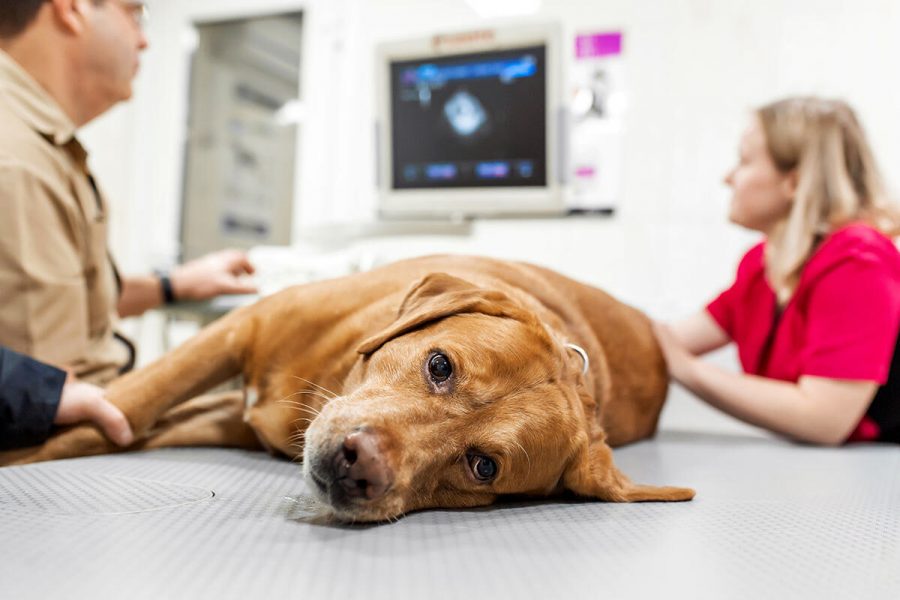Even though humans and dogs are mammals, their diets are not quite the same. Dogs need a number of vitamins because they are not able to synthesise all of them. In addition, their bodies cannot eliminate certain toxins present in many of the foods we consume. You must therefore be vigilant during meals as well as during their preparation, especially if your pet is a bit of a glutton!
What is food poisoning?
It is simply poisoning resulting from the ingestion of a food. The degree of severity is very variable. While for some the effect is immediate, for others, the consequences gradually develop over time and are thus more difficult to detect. For example: milk, or rather, the lactose contained in milk, can cause diarrhoea. This is not particularly serious, unlike garlic, which causes the destruction of red blood cells and can thus put the animal’s life at risk.
What are the symptoms of food poisoning in a dog?
There are no hard and fast rules, the symptoms are… variable! But, rest assured, we have summed up the most common symptoms in dogs for you:
- Diarrhoea;
- Vomiting;
- Sluggishness;
- Hypersalivation;
- Tremors;
- Seizures;
When in doubt, there’s only one thing for it: call your veterinarian. In addition, be aware that the Poison Control Centre is also available by phone 24/7 to answer your questions.

Top 6 most toxic foods for a dog
The level of toxicity varies according to: the food, the amount ingested, and the weight of the animal.
Chocolate
The star food of many feast days such as Christmas, Easter, Valentine’s Day, but also commonly found in everyday life, chocolate is typically the No. 1 enemy of dogs to the point that this food is the leading cause of deadly poisoning in dogs.
Why? Cocoa contains a substance called theobromine which is toxic to a dog’s nervous system as well as their heart.
This substance is found in high concentrations in dark chocolate (>50% cacao), slightly less in milk chocolate and absent in white chocolate. Because yes, contrary to what the name suggests, white chocolate does not contain cocoa.
Nevertheless, we must still be wary of it because it also has its flaws. It is a very high-fat food, so it can cause obesity if consumed in large amounts (from a dog’s perspective).
In what dose? Not all dogs react the same way. Dogs with heart problems will be particularly sensitive to chocolate, so be wary.
Just 30 g of dark chocolate (or 6 small squares) is enough to poison a 5 kg dog. This is equivalent to 60 g (12 small squares) for a 10 kg dog, or 120 g for a 20 kg dog.
What are the symptoms? Signs appear a few hours after ingestion:
- Agitation;
- Vomiting;
- Diarrhoea;
- Accelerated breathing;
In the most severe cases, the animal convulses and may die. We must therefore be very vigilant with chocolate around canines.
Garlic, onions, leeks
These three foods belong to the genus Allium which also includes shallots, chives and many others.
At first glance, there is little chance that your dog will be attracted to them, right? Yet, onions are the second leading cause of poisoning in dogs! How is that possible? Are dogs secretly onion fans?
Not quite: in reality this family of foods is present in many prepared dishes, and this includes jars of baby food. By allowing your pet to lick the remains, you can – without realising it – give onion to your dog.
Why? It is the sulphur derivatives that are responsible. Found in garlic, onions, and the rest of the Allium family, they destroy your pet’s red blood cells and lead to anaemia.
In what dose? Toxicity is estimated at around 5 to 10 g per kg of weight of the animal, i.e. between a half to a whole onion, or 2 cloves of garlic for a dog of 10 kg. So it can happen very fast.
What are the symptoms?
- Fatigue;
- Indigestion;
- Respiratory difficulties that can lead to death;

The characteristic sign of this intoxication: urine is dark, even brown.
In addition, it is important to know that Japanese breeds such as Akita or Shiba Inu are even more sensitive to these foods.
Avocado
Every part of the avocado is toxic to dogs. Whether it is the fruit, the leaves, or the seed, it is to be thoroughly avoided.
Why? The toxic substance is a fatty acid called persin. But little is known about its mode of action.
In what dose? Nobody knows for sure. Doses vary from one individual to another. While some dogs will not report any symptoms, others will react with small doses. Nevertheless, the higher the dose ingested, the more serious the consequences will be.
In other words, at the slightest ingestion, contact your veterinarian.
What are the symptoms?
- Diarrhoea;
- Vomiting;
- Respiratory difficulty;
- Cardiovascular disorders that can lead to death;
The raw potato and its tubers
When it is raw, or has green or sprouted tubers, the potato represents a real danger to dogs. So be careful not to leave your peelings within reach.
Why? Solanine, a substance found in the skin of potatoes as well as other vegetables such as eggplant or tomato, is to blame here. It attacks the nervous and digestive system of the animal.
In what dose? The toxic dose is estimated to be about 300 g for a 10 kg dog.
What are the symptoms?
- Diarrhoea (sometimes blackish);
- Vomiting;
- Hypersalivation;
- Tremors;
- Loss of balance;
- Body temperature above normal;
Symptoms may appear 2 to 3 hours after ingestion.
Potato poisoning is generally treatable, however a few fatal cases have been reported in small dogs.
Grapes
Even though in bunches it can tickle whiskers, and its fruit amuses by rolling in all directions, the grape is not the friend of dogs at all.
Why? That’s what scientists want to know! The toxic substance has not yet been identified. However, it is known that it is particularly concentrated in raisins. So take extra care when enjoying nibbles with a drink.
In what dose? Toxicity is evaluated at about 10 g per kg of weight of the animal, i.e. a small bunch for a dog weighing 10 kg. But again, not all dogs are equal. While some may eat large amounts of grapes without showing any symptoms, others may suffer poisoning with just a few.
What are the symptoms?
- Diarrhoea;
- Vomiting;
- Anorexia;
- Abdominal pain;
- Acute renal failure that can lead to death;
Macadamia nuts
Queen of appetisers but also found in cookies and cakes, macadamia nut – as well as other nuts – can cause serious health problems to your dog.
Why? Like grapes, researchers are still working on the subject. The toxic substance is currently still unknown.
In what dose? Although no cases of mortality have been identified, the intensity of the symptoms will depend on the amount ingested. 20 g of macadamia nuts can poison a 10 kg dog.
What are the symptoms?
- Vomiting;
- Nausea (dog that swallows its saliva constantly);
- Trouble walking;
- Tremors;
Symptoms appear a few hours after ingesting the nuts.
What should I do if my dog has eaten a toxic food?

If your pet has consumed one of these foods, it is imperative to contact your veterinarian or an emergency veterinarian as soon as possible. It is best not to try any remedy (e.g. make your pet vomit), but to rely first on the advice of your veterinarian who will tell you what procedure to follow.
You may also be Interested in: Canine Socialization
